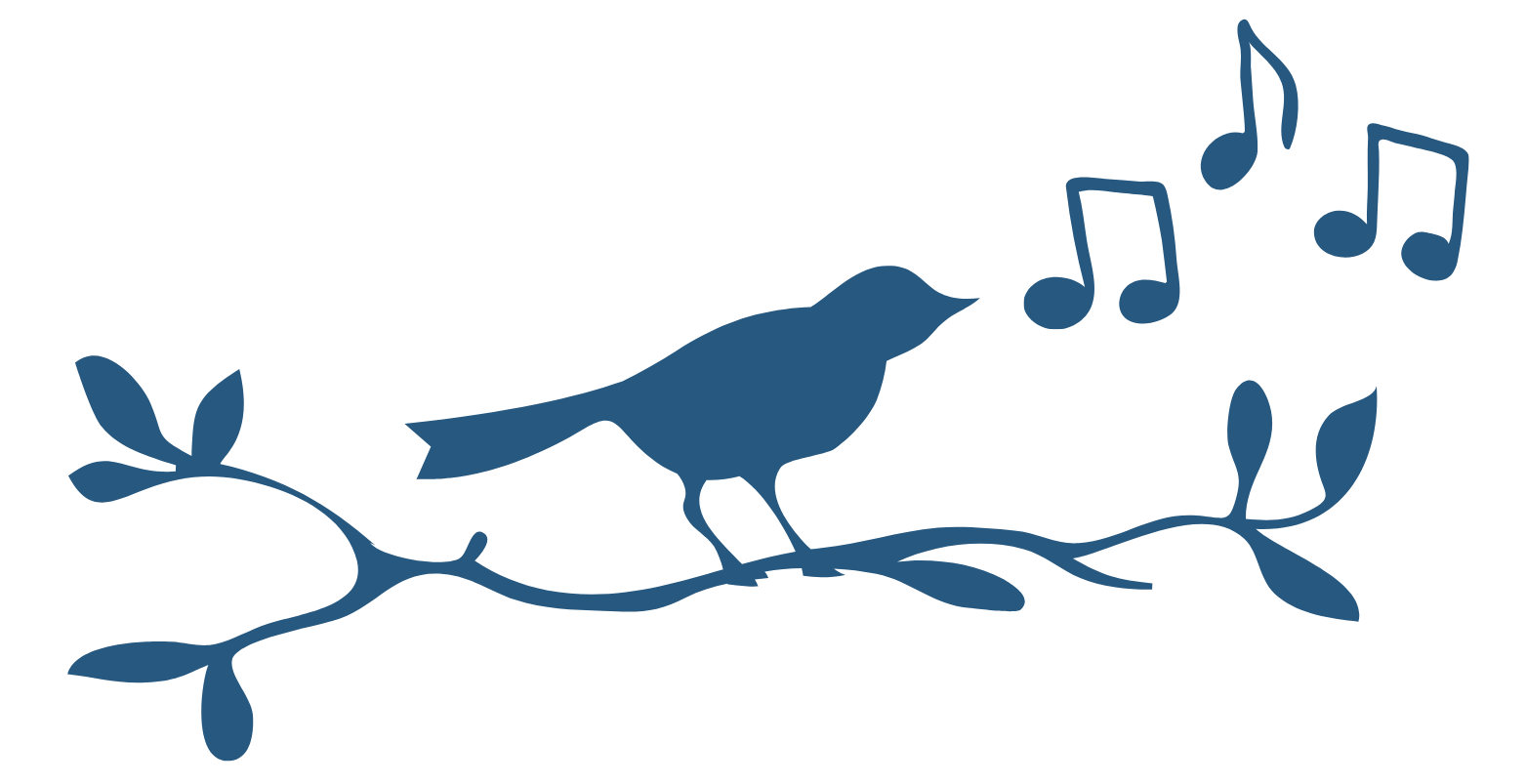3 Basics on How to Accompany Yourself on Piano + Chord Chart

Playing piano while singing is such a great feeling. When I first started to accompany myself, it was refreshing to know that I could practice by myself and get lost in the music that I was creating. This is one skill I would recommend for every singer, so here are the three basic steps to learning to accompany yourself on piano.
To accompany yourself on piano, you need to learn chords, rhythm and the notes of the keyboard. Once you have learnt these basics, you can find the chords of any song and play them on piano. The best chords to learn first are C, F, G and Am (A minor). These can be applied to most mainstream songs.
I will explain these three steps in more detail below, in a way that you can understand with no musical background. You will also find an easy reference chart for the main chords you will come across in a song.
1. Learn the Musical Alphabet
A to G: The White Notes
The musical alphabet consists of 7 letters: A, B, C, D, E, F and G. The first white note on an 88-key keyboard (furthest to the left) is an A. Each white note from the bottom up follows this same pattern, starting back at A after every G.
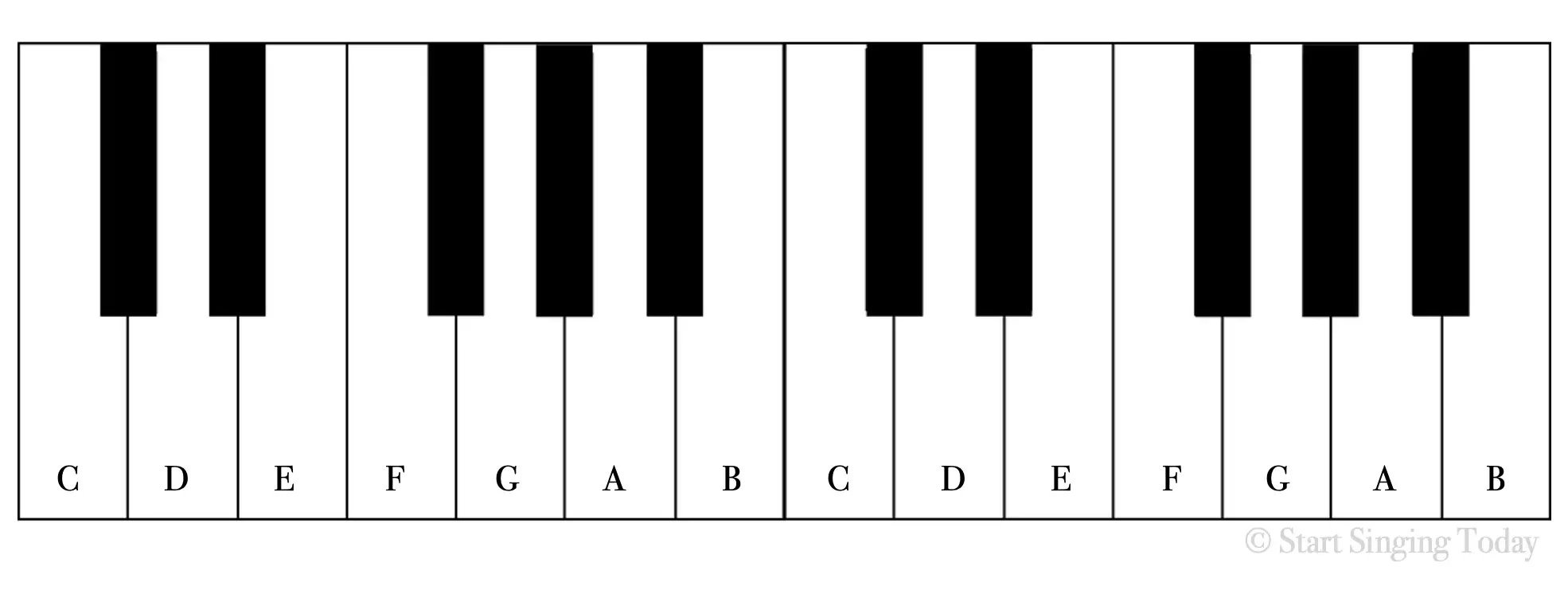
Octaves
The keyboard is also divided into what is known as 'octaves'. An octave is the distance between one note to the next same note. For example, jumping from the A at the bottom of the keyboard to the next A is a one-octave jump. Therefore, we can distinguish each note by it's octave number as well.
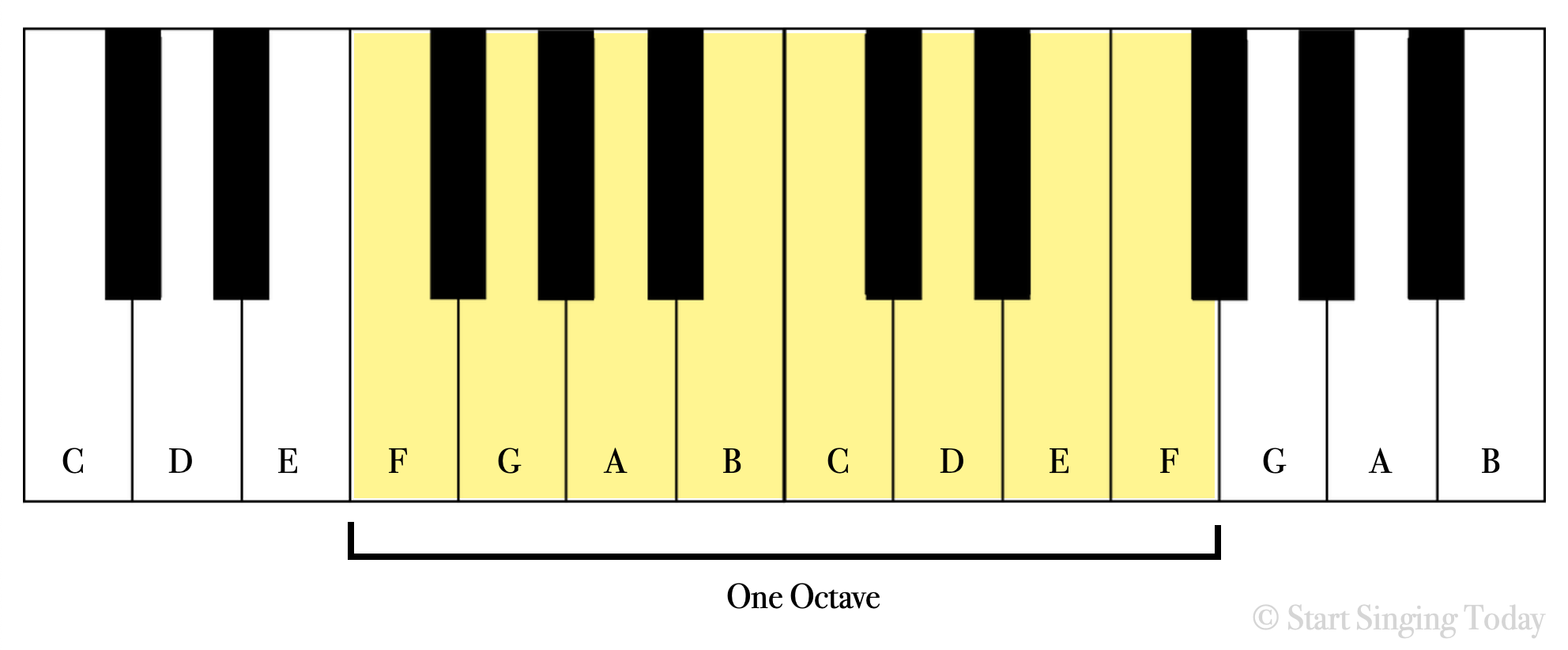
Sharps and Flats: The Black Notes
There are also black notes on the keyboard. These notes sit between the white notes because they have the same names, but are either a half-step above (known as a sharp note: '♯') or a half-step below (known as a flat note: '♭'). For example, the black note to the right of a C can either be a C♯ (C sharp) or a D♭ (D flat).
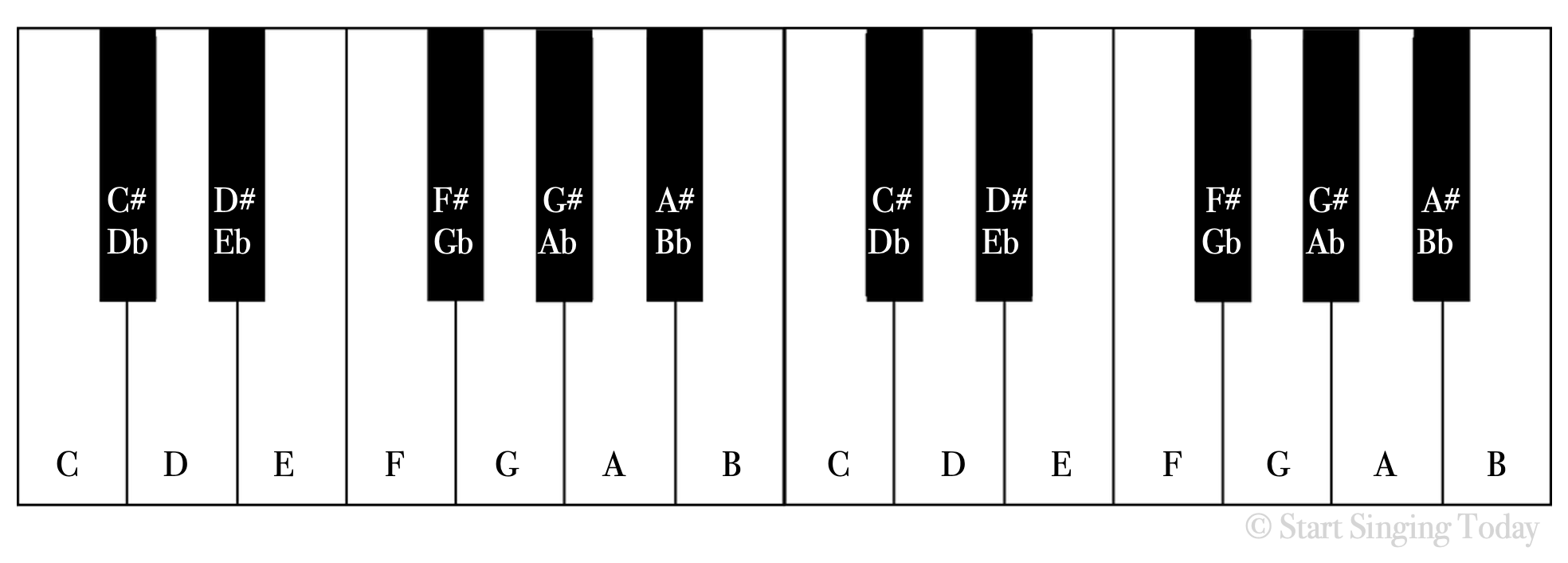
The black notes can also be distinguished by their octaves. With this in mind, you should be able to find and name all the notes on your piano.
2. Learn the Chords
Basic Chord Structure
Basic chords are made up of three different notes. These notes are the 1st, 3rd and 5th notes of the scale. For a detailed beginner's explanation of scales, click here. These three notes are played at the same time, normally by the thumb, middle finger and pinky finger, to play the chord.
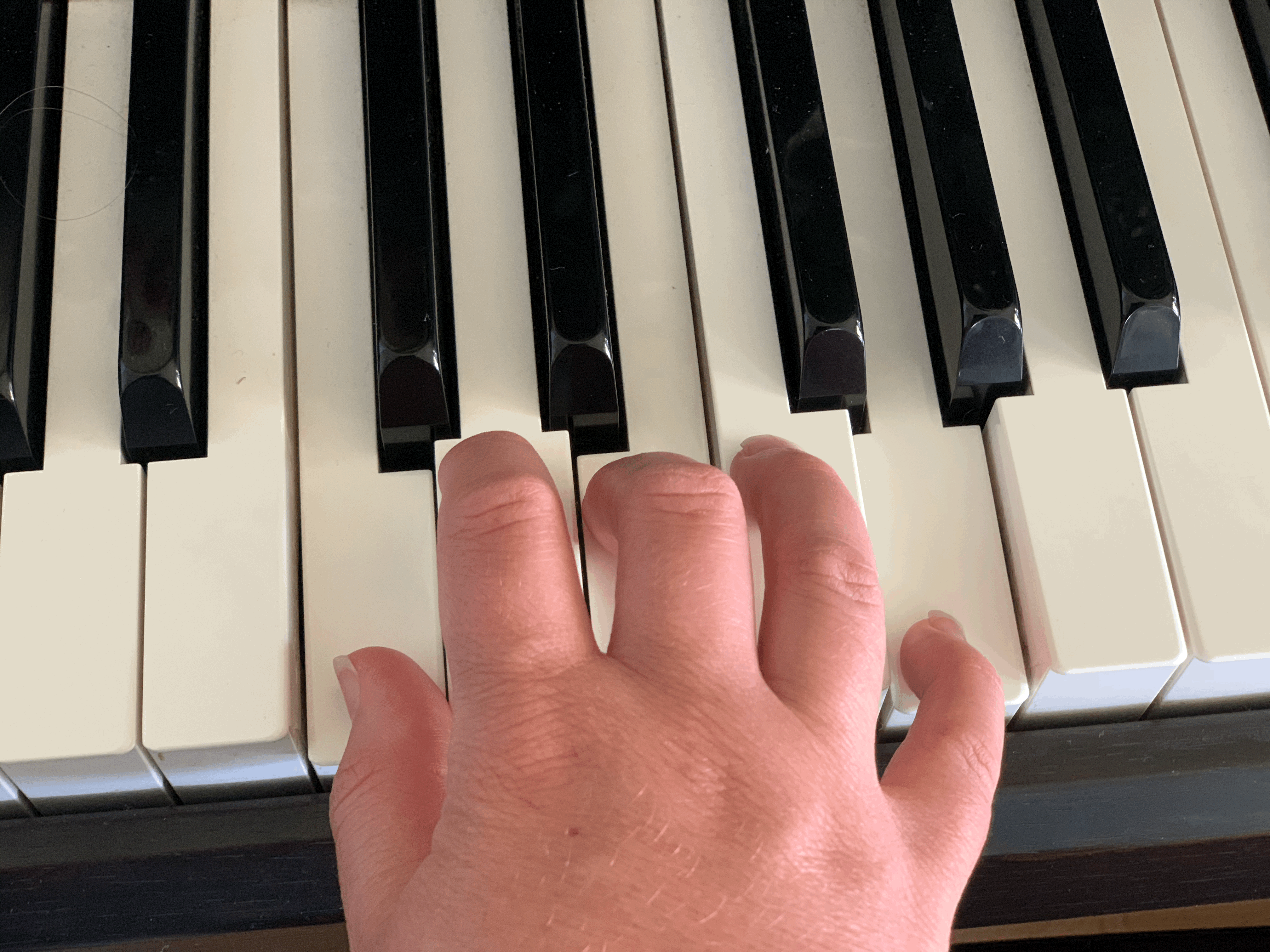
Major and Minor Chords
The main two chords you will come across in songs are major chords and minor chords, derived from their corresponding major and minor scales. As a basic explanation, major chords have a happy sound to them, while minor chords sound sad.
Overall, there are 12 major chords and 12 minor chords. If you don't want to get caught up learning their corresponding scales (although I recommend every singer learns these basics!), you can learn each chord as you go.
Any note that is by itself (including ♯'s and ♭'s) represents a major chord. If the note has an 'm' next to it, this represents the minor chord of that note. For example, 'G' on a chord chart is a G major chord, while 'Gm' is a G minor chord.
If you learn every chord in the song you want to sing, you will normally only have to learn four chords for each song. So you can see that it won't take too long to learn them all if you learn them as you go.
For convenience, you can find a $3 chord chart bundle further down that contains all 24 major/minor chords. You can use this as a reference while you learn the chords.
Chords with Numbers
There are also chords with small numbers next to them, such as 'F²' or 'G#7'. Any number after a chord represents playing an extra note in the chord. The number represents that note from the corresponding scale.
Using the F² (or F2) example, this chord is played using the 1st, 2nd, 3rd and 5th notes of the F major scale. But for simplicity, you do not have to play this extra note.
Learn Your First Four Chords
The easiest four chords to learn use only the white notes. They are therefore the easiest to remember and find on the keyboard. You will also find that many popular songs use these four chords: C, F, G and Am.
If you learn these four chords, you have just taught yourself the most common group of chords used in mainstream music. These chords are the 1st, 4th, 5th and 6th chords of the C major scale.
Take a look at the free reference chart further down to learn these four chords.
Chords and Key Signatures
Other songs may also use the 1st, 4th, 5th and 6th chords, but may take them from a different scale. For example, the A major scale would use the chords A, D, E and F♯m.
Note that the 6th chord of the scale is always a minor chord. This is known as the 'relative minor'.
The scale that these chords are taken from determines the 'key' of the song. Songs that use chords taken from the C Major scale are in the 'key of C', whereas songs using the A Major scale are in the 'key of A'.
Because many songs use the 1st, 4th, 5th and 6th chords in their key signature, this means that you can continue using the same four chords (C, F, G, Am) by transposing the song into the key of C.
This simply means you are changing the key of the song. You are using the chords of one key in place of the chords from another key. There are two main benefits of changing the key of a song:
- Makes the song easier to play by using easier chords (or chords that you know).
- Makes the melody higher or lower so that it is easier to sing.
There is often an option on websites that supply chord charts to change the key of (or 'transpose') the song. This will change the key/chords automatically for you.
Chord Reference Chart
Download our free chord chart PDF with your first four chords: C, F, G and Am.
Once you've learnt these four chords, I recommend learning the rest of the major and minor chords. You can buy the bundle below for just $3.
3. Find Your Rhythm
Once you know how to recognise chords and play them on the piano, you need to know when to play them. Chord charts will provide you with both the lyrics of the song and the chords you need to play. Their relationship will help you find the rhythm of the song.
Chords and Lyrics
Every chord played throughout the song will be written above each line of the lyrics. This will tell you (approximately) when to play each chord. For example, if the chord is above the word 'go' in Let it Go, you play the chord when you sing 'go'.
This is a very basic introduction to the timing of chords, but relying on this method will almost always let you down. Often the chords are in the wrong position and it is hard to determine if the chord is played at the same time, just before, or just after you sing the word.
Understanding Time Signatures
This is why it is important to understand basic time signatures in music. This is essentially the 'beat' of the song, which is usually driven by the drums. When you listen to a song and tap your foot, your foot is tapping in time with the music. This is the rhythm of the song that you need to follow when changing chords.
The most common time signature is '4/4'. I'll start technical but then try to simplify it. This means that there are four beats in every bar (the first number) and that those beats are a quarter note (crotchet) in length. The length of the notes is more technical, so you can learn more about that later if you want to.
The number of beats, however, is a good indication of how long you need to hold each chord. In the above example, you need to hold the chord for four beats. Or in even simpler terms, hold the chord for four toe-taps. This means you are holding the chord for one whole bar.
Sometimes chords are held for two bars (eight beats in this example), or even half a bar (two beats). Regardless, it should fall into that driving rhythm of the drums. Have a listen to the song to hear when the chords change.
Once you get a sense for the rhythm of the song, you should be good to accompany yourself. Below is a general guide to using both hands.
Playing the the Chords with Both Hands
To start accompanying yourself on piano, you should use both hands. Your right hand will play the three notes of the chord using your thumb, middle finger and little finger.
Your left hand will play one note further down on the piano. This note is the first note of the chord, but one octave lower than your right hand. This gives the chords more depth as your play.
Do this for every chord in the song and hold it until you need to play the next chord.
Tip: Hold down the sustain pedal (the foot pedal under the keyboard or piano) while you move your fingers to the next chord. This pedal holds the notes even when you take your hands off the piano. This will make the transition smoother when you change chords.
Once you are comfortable with this, you can play the entire song and it will sound great. However, to fill in some of the gaps in the song (when the chords are held for a long time), you can try playing the chord multiple times to the beat of the song.
For example, if the chord is held for four beats (a whole bar), play the chord on each beat instead. In this style, your left hand could either play the one note on each beat, or you could hold that note while the right hand plays on each beat.
There is so much more that you can learn regarding accompanying yourself on piano, but these are the basics to get you started. Now go and enjoy the fun!
